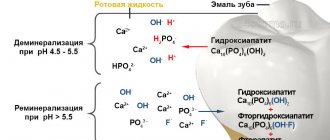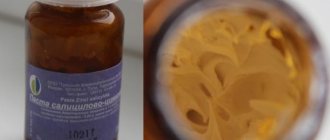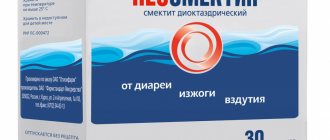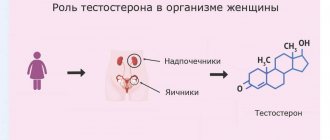Pharmacodynamics and pharmacokinetics
This remedy is often referred to as Vitamin B5 or Pantothenic acid . You need to know what it is and why it is needed to understand the principle of action of the drug. This substance is very common in nature. pantothenic acid is very common in foods; liver, egg yolk, peas, kidneys, fish roe, and yeast are rich in it.
In the body, it is part of the acetylation coenzyme , which influences the processes of acetylation and oxidation. In addition, pantothenic acid (vitamin B5) takes part in metabolic processes and the synthesis of acetylcholine . It is found in significant quantities in the adrenal cortex and activates the formation of corticosteroids .
The body's daily need for pantothenic acid is about 11 mg. With significant physical activity, as well as during breastfeeding , the need for it increases to 20 mg. It is produced in the body by E. coli , so it is not necessary to consume foods that contain pantothenic acid ; vitamin deficiency is not observed due to its deficiency.
of pantothenic acid is used as a medicine . It is obtained synthetically. Pantothenic acid preparations are used for various pathological conditions that are associated with metabolic .
METABOLISM OF VITAMIN B5
Every day, the intestinal microflora of a healthy body synthesizes 3.4 milligrams of vitamin B5. After food intake, pantothenic acid is absorbed by diffusion directly from the intestine into the blood and tissues, where it is subsequently captured by red blood cells and actively transformed into coenzyme forms - coenzyme A and phosphopantothein. The remaining part of the substance circulates in the body in a free state. The catabolism of organic compounds of non-protein nature is based on their hydrolysis, while “waste” calcium pantothenate and its metabolites are excreted in the urine.
Vitamin B5 is sensitive to heat; heat treatment of foods rich in the beneficial compound leads to a loss of 50% of the substance. It is destroyed not only under the influence of dry heat (grill, oven), but also as a result of exposure to solutions of acids and alkalis that are used in food processing, for example, during canning and freezing.
It is important to remember that pantothenic acid is found in foods exclusively in protein form and is released with the help of enzymes.
Indications for use
The use of this remedy is indicated for polyneuritis , paresthesia , eczema , neuralgia , photodermatoses , lupus erythematosus . In addition, it can be prescribed for catarrh of the upper respiratory tract, various allergic reactions , trophic ulcers , burns , toxicosis of pregnancy, bronchial asthma , gastric and duodenal ulcers , pityriasis rosea , bronchitis , intestinal atony after surgery, poisoning with streptomycin arsenic preparations . Recently, this remedy has also been included in the complex therapy of withdrawal syndrome in the treatment of alcoholism .
To determine what Pantothenic Acid may be used for in each specific case, you should consult your doctor.
special instructions
If there are disturbances in the intestinal microflora, a higher dosage of the vitamin may be required. Also, an increased rate is required for people exposed to regular physical and mental stress. The active substance is destroyed at temperatures above 50 0C, so consuming thermally processed foods cannot always cover the body’s need for the vitamin.
It is recommended to take pantothenic acid supplements in the morning. Pregnant and breastfeeding women are advised to start taking it only after consulting a doctor. It is not recommended to exceed recommended doses when using the product by children.
Nature's Way, Pantothenic Acid, 250 mg, 100 Capsules
785 rub.
More details
Instructions for use of Calcium Pantothenate (Method and dosage)
Pantothenic acid is administered intramuscularly or intravenously .
For adult patients, a dosage of 0.1-0.2 g is indicated. Injections are given 2-4 times every day. Children 1-3 years old can be given 0.005–0.1 g of medication at a time, from 3 to 14 years old – 0.1–0.2 g can be administered. Injections are given 2 times daily.
For the treatment of dermatological diseases , the drug is used in a daily dosage of 1.5 g for adult patients and 0.2-0.6 g for children 2-3 times daily.
In the case of intestinal atony after surgical interventions, adult patients are administered 0.3 g every 6 hours. Depending on the characteristics of the disease, therapy can last up to two months.
Instructions for use of Calcium Pantothenate parenterally states that it should be administered to adult patients 1-2 times daily in a dosage of 0.2-0.4 g. For children under 3 years of age, a single dose of 0.05-0.1 g is indicated, and for children from 3 to 14 years the medicine is administered 1-2 times/day in a dosage of 0.1-0.2 g.
If it is necessary to correct adverse reactions of anti-tuberculosis pantothenic acid preparations are taken throughout the entire course of therapy.
In case of withdrawal syndrome in people suffering from alcoholism , 0.5 g of 10% solution per day is administered intramuscularly or intravenously. And for alcoholic delirium, a 10% solution is used. Dosage – 1 g. The course of application is designed for 10 days.
The drug solution can also be used in the form of aerosols. This is done in case of diseases of the respiratory system. Then dissolve 0.2 g of the drug in 5 ml of water and obtain a 4% solution. It is inhaled for 10-15 minutes every day. The course of application is designed for 7-8 days.
Use of tablets
Tablets are taken before meals. The dosage for children from one to 3 years old is half a tablet per day, from 3 to 14 years old - one or two tablets twice a day. From 14 years of age you should take one or two tablets up to four times a day.
How do toothpastes work to restore enamel?
Anyone who cares about dental health has probably asked the question more than once: “how can you strengthen tooth enamel?”
If your teeth have become sensitive or stains have appeared on your teeth, this is certainly a reason to consult a doctor, sort out the problems and choose treatment; home care may not be enough; serious in-office remedies may be needed.
However, as a preventative measure, strengthening the enamel is possible with the help of properly selected toothpastes. To understand, we will first delve a little deeper into chemistry.
Let's understand the processes in tooth enamel, pay attention to the composition of toothpastes, and by combining this knowledge, you will be able to choose your own toothpaste to restore teeth, but do not forget to consult with your doctor.
So, tooth enamel is the hardest tissue, which consists of 96% of inorganic mineral compounds - phosphorus, fluorine, calcium and other components. But despite her hardness, she is quite vulnerable. To find out why, let's delve a little deeper into chemistry.
The main compound of enamel is hydroxyapatite, and few people know that in the surface layer of enamel, hydroxyapatite crystals undergo constant changes. When the pH of saliva becomes acidic (in other words, teeth are not brushed), the hydroxyl group from our hydroxyapatite turns into water!
The crystal lattice is broken, calcium is released, and the vulnerability of the enamel to acids has increased. This is the process of demineralization of enamel at the molecular level. If there is an excess of calcium or phosphorus ions in the periodontal environment, then the reverse process will begin - mineralization.
What about fluoride? And fluorine ions form a modification - hydroxyfluorapatite is a fairly acid-resistant compound, and in high concentrations calcium fluoride is a generally insoluble compound.
In conditions of healthy oral microflora and normal saliva composition, the natural processes of demineralization and remineralization occur constantly and ensure a balanced mineral balance of tooth enamel.
The source of calcium and phosphate ions is saliva, and poor hygiene and poor nutrition contribute to the proliferation of bacteria, which in turn contribute to the accumulation of acids in the oral cavity.
So daily brushing of teeth is not just a hygienic procedure, it is a war for the strength and durability of the enamel of your teeth.
Indications for strengthening enamel
- The main indications for strengthening tooth enamel are:
- Caries at any stage.
- Baby teeth.
- Pregnancy and breastfeeding period.
- Discomfort or toothache while eating.
- Time before and after teeth whitening procedure.
- Orthodontic treatment (braces).
- Chips, scratches and cracks on teeth.
- Bite abnormalities and, as a result, pathological abrasion.
- Long-term drug therapy.
How do toothpastes work to restore enamel?
Most researchers agree that the main source of substances entering the enamel is oral fluid. There is also a very important detail: enamel has high permeability, due to the presence of microspaces filled with water through which various substances can penetrate, depending on their radius and activity. For example, the fluoride ion is large and active, therefore it is embedded quickly and only into the surface layers of the enamel, while the calcium ion is the opposite, so it manages to penetrate much deeper.
All this was proven through long-term research and based on these details, remineralization schemes were created - artificial saturation of tooth enamel with minerals.
Since ions penetrate the enamel through a slow diffusion process, remineralization requires time and therefore multiple manipulations.
Most of all, tooth enamel needs an element such as calcium. The strength and hardness of teeth depends on it. Calcium-containing pastes are suitable for restoring the enamel layer with minor damage. They contain various calcium compounds that penetrate dental tissue, strengthen and restore them.
Toothpastes with calcium are especially useful for primary signs of demineralization. Damaged enamel, which may periodically show itself with increased sensitivity, needs to be healed with pastes containing active calcium;
In case of serious damage to the enamel layer, it is recommended to use fluoride-containing pastes. Pastes containing fluoride, when cleaning the oral cavity, actively react with calcium ions, filling microcracks and damage to the enamel.
Penetrating into the enamel layer, the substances are integrated into the structure of the tissue, restoring and strengthening it.
It is useful to alternate fluoride-containing paste and calcium paste. It is undesirable for both components to be present in one tube, since together they form an insoluble salt. Because of this, when brushing your teeth, active fluoride and calcium ions will not be released from the paste, so there will be no benefit from such therapeutic cleaning. Modern research does not stand still, constantly modifying and improving the compositions of toothpastes. But there are still “old” toothpastes on the market that do not provide any benefit to teeth. I recommend carefully studying the composition of toothpastes and consulting with your dentist; some of them are reliable and proven
Toothpastes for restoring enamel with calcium
We have already seen that calcium ion has very weak activity. Therefore, it is very important that its form in toothpaste is easily absorbed by tooth enamel.
Calcium in toothpastes can be contained in the form of the following compounds:
- Calcium citrate.
- Calcium pantothenate.
- Calcium lactate.
- Hydroxyapatite.
Very often you can find a combination of two or three of these calcium compounds in toothpaste, which, of course, increases the chances of calcium being incorporated into the tooth enamel, and therefore strengthening the teeth.
Calcium citrate replenishes calcium deficiency in the body and is safe to swallow. The calcium in this compound easily penetrates tooth enamel, strengthening and protecting it.
Calcium pantothenate is a widespread calcium compound present in the body and actively involved in metabolism. It enriches teeth with essential calcium and is safe when ingested.
Calcium lactate is used in the food industry to fortify foods with calcium and as a substitute for table salt. It is perfectly absorbed by the body and protects against caries.
“Good old” calcium glycerophosphate. It has been established that toothpastes based on calcium glycerophosphate effectively remove plaque, stabilize the cariogenic situation in the oral cavity and do not have a sensitizing effect on the body. Pastes containing calcium glycerophosphate are time-tested, affordable and reliable. For all conservatives for complex therapy of superficial caries.
For those who love innovation.
Nanotechnology has reached toothpastes. Hydroxyapatite itself is by no means an innovation in dentistry. Experiments on its use took place at the beginning of the 20th century, but only at the end did Japanese scientists manage to develop nanocrystalline medical hydroxyapatite. This artificially synthesized form is maximally biocompatible and bioactive.
Over time, the formula has been improved, the particles have decreased, and today toothpastes containing nanohydroxyapatite are leading in the prevention of caries. Its effectiveness has been proven in the initial stages of caries, due to the ability of ions to penetrate into the microscopic spaces between enamel prisms, embedding themselves in the crystal lattice of hydroxyapatite crystals of tooth enamel. As a result, tooth enamel is restored.
Toothpastes with nanohydroxyapatite eliminate caries at the white spot stage and “seal” microcracks; reduce tooth sensitivity.
An indispensable assistant at the first signs of problems with tooth enamel.
Another contender for special treatment
Amorphous calcium phosphate. When in contact with saliva and hydroxyapatite, this element forms a special biofilm on the surface of the teeth, which: protects the enamel from the harmful effects of acids and ensures the connection of bioavailable calcium with the enamel, accelerating its remineralization.
Important! Since the active substance is obtained from cow's milk casein, this method of strengthening enamel is not suitable for people with allergies to milk protein.
Theobromine is for lovers of natural and maximally safe, expensive and chic. Theobromine (cocoa bean extract) acts as a catalyst; it stimulates the formation of its own hydroxyapatite crystals, providing natural remineralization of enamel. Calcium acetate serves as a building material for the crystal lattice of tooth enamel.
The enamel becomes denser and more resistant to acids. Studies have confirmed the beneficial effects of theobromine on tooth enamel and its high effectiveness in combating tooth sensitivity.
Please note that forms of calcium not listed above are merely abrasives in toothpaste (for example, calcium carbonate or dicalcium phosphate). Therefore, when choosing a toothpaste to strengthen your teeth enamel, be guided by the calcium compounds described above, or consult your dentist.
Toothpastes for strengthening enamel with fluoride
Every person knows: fluorides protect teeth from caries! But there is other known information - fluoride is toxic to the body. How to be? Who to believe? Let's figure it out.
In our body, elements such as fluorine and calcium are divided into macroelements, there should be a lot of them, and microelements, they are needed, but in small quantities. For example, the daily calcium intake for an adult is 1000-1200 mg. While the norm for fluoride is only 4 mg. But, did you know that with an excess of calcium and vitamin D in the body, the risk of urolithiasis increases. And excess iron in the blood also causes toxic effects and is called iron overload syndrome. And so the list can be endless.
Important! Everything useful is useful in moderation! Same with fluorine.
How to understand whether it is needed and whether it will not be harmful?
First of all, determine what fluoride content is in the water in the region where you live. Since we get the most fluoride from drinking water. You can find up-to-date information about fluoride levels in water in your area on the website of your local water utility.
In Russia, the fluorine content in water from natural sources is usually low - less than 0.5 mg/l. Only in the groundwater of the Tver, Moscow, Ryazan, Sverdlovsk and Chelyabinsk regions the concentration of fluorine is increased (reaches 4.4 mg/l). There is also a list of regions where, due to large production, the fluoride content is also increased.
Only in regions with high levels of fluoride in water are toothpastes with fluoride contraindicated. Everyone else needs and benefits from fluoride in the right dosages.
What are the benefits of fluoride?
Fluoride performs important tasks in the body.
- Together with phosphorus and calcium, it participates in the formation and strengthening of bone tissue and tooth enamel.
- Promotes healthy nail and hair growth.
- Stimulates hematopoietic processes: formation, development and maturation of red blood cells, platelets and leukocytes.
- Strengthens the immune system and maintains it at an appropriate level.
- Removes salts of radionuclides and heavy metals from the body.
- When used in oral care products, fluoride helps prevent dental problems and solve existing ones.
- Prevent tooth decay. Fluoride penetrates the enamel structure, prevents caries and treats it at the white spot stage.
- Protect against demineralization. The combination of fluorine with hydroxyapatite forms fluorohydroxyapatite, a substance that reduces it. This is how enamel remineralization occurs.
- Protect against lactic acid. Fluoride prevents bacteria from producing lactic acid. This reduces the growth of pathogenic microflora and gives the enamel additional protection.
Why is fluoride deficiency dangerous in the body?
Fluorine deficiency in the body is most often caused by its low content in drinking water (less than 0.7 mg/l). Another possible cause is improper regulation of fluoride metabolism in the body. A deficiency of this substance weakens tooth enamel, making it more vulnerable to caries. A child with a lack of fluoride may experience delayed ossification and defects in bone mineralization. In an adult, with prolonged deficiency, the risk of developing osteoporosis increases.
If there is too much fluoride in the body
Fluoride is found not only in oral care products and tap water, but also in food. The maximum permissible daily intake for an adult is 10 mg. An excess of fluoride is more dangerous for the body than a deficiency, as it entails irreversible processes. First of all, teeth and bones are affected; metabolic disorders, deterioration of blood clotting, etc. may occur. In children, even before teething, endemic fluorosis develops - this is a chronic lesion of tooth enamel in the form of spots of various sizes, shapes and colors. After 10–20 years of excess fluoride in the body, bone fluorosis develops, which can develop into osteosclerosis, osteoporosis and osteosarcoma (malignant formation). As a rule, we are talking about excess fluoride entering the body for a long time with water and food or, for example, toxic production. It is also possible that fluoride metabolism in the body is impaired, which is rare.
Is fluoride from toothpaste harmful?
We figured out that the toxic effect of fluoride, which some fear, is due only to ingestion. Should you be afraid of fluoride toothpaste? No! When brushing our teeth, we do not swallow toothpaste. And fluorine, as we remember, an element with high activity, quickly reacts with hydroxyapatite of tooth enamel, settling in its surface layers and does not have time to penetrate through the tooth into the bloodstream. This means that when brushing your teeth 2 times a day, toothpaste with fluoride does not cause any harm. And the concentrations of fluoride in toothpastes are strictly limited. The amount of fluoride in ppm is usually indicated on the packaging. The abbreviation ppm stands for parts per million and reflects the number of fluorine particles per million. If the tube states that the toothpaste contains 900 ppm of fluoride, this means that 1 kg(!) of toothpaste will contain 900 mg of this element.
The higher the fluoride concentration, the better the paste restores enamel. For prophylactic pastes it is 900-1150 ppm, for therapeutic and prophylactic pastes it is 1350–1500 ppm. There are products with higher content, but they are used only as prescribed by a doctor and in short courses. As a reminder, these recommendations are suitable for anyone living in areas with moderate levels of fluoride in their drinking water.
Can children have fluoride toothpaste?
The European Academy of Pediatric Dentistry (EAPD) recommends fluoride pastes and gels for everyone - even children and pregnant women - to prevent early stages of tooth decay.
Recommended fluoride content in toothpaste:
- up to 4 years - 200 ppm;
- from 4 to 8 years - 500 ppm;
- over 8 years old and for adults - 1450 ppm.
Fluoride is an important component in caring for children's teeth. However, if the toothpaste is swallowed frequently, fluoride accumulates in the body and can cause unpleasant consequences. Important! The child brushes his teeth under the supervision of an adult!
Children can begin brushing their teeth with fluoride-containing toothpastes when their first tooth erupts. Because the recommended amount of toothpaste when brushing your teeth is a grain of rice. And the amount of fluorine is 200-250ppm. That is, it is 200 mg in 1000 mg paste. Tube with children's toothpaste 50ml. Even if we roughly translate, without taking into account the density of the substance, that ml is equal to mg, then we get 10 mg of fluorine. It turns out that for the toxic effect of fluoride to manifest itself, the child must eat the entire tube of toothpaste at one time! Agree, if a child eats a whole tube of cream or anything else, this will also cause problems. Therefore, it is recommended to keep any attractive tubes away from children. And the child brushes his teeth under adult supervision.
How do fluorides affect enamel?
Fluoride ions interact with calcium ions, forming calcium fluoride, which is built into the structure of tooth enamel, restoring and strengthening it. Therefore, in order to fix calcium in the teeth and slow down the carious process, it is recommended to use fluoride-containing products to restore teeth. After all, as we discussed at the beginning of the article, hydroxyfluorapatite is a more acid-resistant compound, and calcium fluoride is insoluble, which means that enamel with such structural elements is stronger and less susceptible to caries. In addition, fluorine has a bacteriostatic effect, which helps to heal the microflora. This is why fluoride toothpastes are so popular among dentists.
However, all fluorine-containing additives have their own characteristics and differ in the speed of action. For example, amino fluoride, which is an organic fluorine compound, forms a persistent protective film on the surface of the enamel. Inorganic fluorine compounds (sodium fluoride and others) also form a protective film, but under the influence of saliva it dissolves faster.
As in the story with calcium, we pay attention to the composition.
Sodium monofluorophosphate. Today it is rare, in old-style toothpastes. It excludes all fluoride compounds. It does not contain fluorine ion, but a solid compound that does not dissolve as easily as ionic compounds. This compound was the result of creative work by chemists as a solution to the problem of combining calcium and fluorine.
What happens to this compound in the oral cavity remains unclear even to the scientists themselves who studied this topic. Some claimed that the element immediately binds to tooth enamel, others said that upon contact with enzymes in saliva, fluoride ion is released. But the secret remained not fully revealed!
Sodium fluoride is the most common supplier of fluoride. It is the simplest fluoride compound: fluorine ion and sodium ion, which are tightly bound to each other due to their charge. Thus, sodium fluoride is a salt that dissolves very easily in water, as well as in saliva (although not as well as regular table salt). Sodium fluoride supplies tooth enamel with fluoride ions, and thereby overcomes the first step in the prevention of caries.
Aluminum fluorides
Also a salt, as in the case of sodium fluoride, but has limited solubility in water, similar to calcium fluoride. Thus, since fluoride ions have a cariesstatic effect, the prospects for protection when using aluminum fluoride compounds are very limited.
For this reason, preference for choosing a product based on it remains minimal.
Zinc fluorides - today only in combination with other fluoride compounds.
Zinc fluoride is also a salt, easily soluble in water. In principle, a good candidate for joining the ranks of toothpaste formulations. Indeed, the first toothpaste with fluoride was based on zinc fluoride, a well-known American brand. But highly reactive zinc ions tend to cause problems! Therefore, the creators are forced to resort to some secrets to stabilize it. This has caused most manufacturers to switch to the more stable sodium fluoride.
In recent years, zinc fluorides have been experiencing a renaissance! Since in combination with amino fluorides they form a stable and effective chain.
Aminofluorides are the product of targeted development and long research!
Amino fluorides are also salts, but compared to sodium fluorides they have a more complex structure. They were the result of a focused search for the best compound to protect teeth from caries. The fluorine ion in the case of amino fluorides is bound into a complex amine molecule by fatty acid hydrolase. The peculiarity of these compounds is their bipolarity: on the one hand, the polar amine base is soluble in water, on the other hand, the nonpolar base is fatty. Such compounds become active on the surface, enveloping it.
| Component | Name on the tube | A comment |
| Sodium monofluorophosphate | Sodium monofluorophosphate | It is ineffective because due to the rate of decay it begins to act only after 3–4 minutes of cleaning. |
| Sodium fluoride | Sodium fluoride | Has a powerful antibacterial and restorative effect. The active substance reduces the ability of bacteria to convert sugar into acid, which destroys enamel. |
| Aminofluoride | Aminofluoride/Olaflur | Recognized as the most effective for caries prevention. Forms a protective film on the surface of the teeth, from which fluoride enters the enamel and strengthens it. |
| Tin fluoride | Stannous fluoride | It is proven effective, but has a side effect: it first lightens the restored areas of enamel, and then leads to their noticeable darkening. |
For home care and caries prevention, you can use toothpastes with fluoride; the most effective are those containing sodium fluoride and amino fluorides. The higher the fluoride content, the better the remineralizing properties of the paste and the protection against caries. But it is better not to use high dosages without a doctor’s prescription.
Fluoride and calcium are equally important for enamel remineralization. However, we remember that when combined they form an insoluble salt and neutralize each other’s effects. Now some manufacturers are trying to get around this problem. In the meantime, follow the proven scheme: alternate the use of pastes with calcium and fluoride.
Which toothpaste is best for strengthening enamel?
Of course, the one that suits you. When making a choice, you should not listen to commercials or the advice of friends.
The state of dental health varies from person to person. Advice from a dentist after a routine examination of the oral cavity will certainly help you decide on the right choice of toothpaste with active ingredients for the restoration and prevention of tooth enamel.
Proper nutrition, regular oral hygiene procedures and the use of only high-quality and highly effective toothpastes will help strengthen the enamel and maintain the health of your teeth.
Interaction
This remedy should not be used earlier than 12 hours after using Proserin and Ditilin .
Calcium Pantothenate improves the energy supply of myocardial contractile function and the therapeutic effect of cardiac glycosides . In addition, it reduces the toxic effects of aminoglycosides , sulfonamides , drugs with arsenic and streptomycin antibiotics .
Conditions for dispensing from pharmacies
Calcium pantothenate preparations are available without a prescription from a doctor. Analogs are prescription drugs.
Now Foods, Pantothenic Acid, 500 mg, 250 Capsules
RUB 1,210
More details
Analogs of Calcium Pantothenate
Level 4 ATC code matches:
Medobiotin
Volvit
Nicotinamide
Alpha Tocopherol Acetate
Riboflavin
Pyridoxine Hydrochloride
Pyridoxine
Vitrum Vitamin E
Calcium Pantothenate analogues are very widespread, but none of them should be replaced independently, without consulting a specialist.
Well-known analogues of Calcium Pantothenate are Aminalon , Neuro-norm , Noobut , Noozam , Noofen and Vasavital . These drugs are prescribed for various diseases of the nervous system. In addition, analogues such as Olatropil , Pantogam , Picamilon , Semax , Phenotropil , Ceregin Evrysam , Omaron , Pantocalcin , Pramistar , Phezam , Ceregin , Evrysam , etc. are also popular.
general information
Calcium pantothenate is a white crystalline compound. Easily dissolves in water. The acid preparation was produced in the form of tablets, injection solution, and powder. In the human body, it is produced by intestinal microflora, and therefore its additional intake is rarely prescribed.
Calcium pantothenate is involved in the regulation of phosphorus-calcium metabolism. It ensures normal functioning of the nervous system and enhances capillary blood circulation. The vitamin is often confused with hopantenic acid (Pantogam, Pantocalcin), claiming that they are the same thing - they have similar functions and similar names, but have different chemical formulas and properties.
Solgar, Pantothenic Acid, 550 mg, 100 Veggie Caps
RUB 1,169
More details
The table below provides basic information about the active substance:
| Latin name | Pantothenic acid, d-calcium pantothenate |
| Active ingredient | Pantothenic Acid (D-Calcium Pantothenate) |
| Manufacturer | Not produced in the Russian Federation in its pure form. Made in the USA (Solgar, Now Foods, Solaray, Nature's Way, Life Extension, Country Life) |
Calcium pantothenate supports energy metabolism and improves the functioning of the nervous system.
Means with similar effects
As acid analogues, drugs from the group of nootropics are indicated:
- Pantocalcin. Hopantenic acid preparation. Produced in tablets and syrup. Prescribed for brain damage and disorders of the nervous system. Can be used from birth.
- Phenotropil. Increases mental activity, enhances the ability to concentrate. Enhances physical performance and helps reduce the pain threshold. It is not recommended to use in the afternoon as the product may affect sleep.
- Pantogam. A drug containing hopantenic acid. Available in the form of tablets and syrup. It has a pronounced nootropic and vasoconstrictor effect. Used in complex therapy of ischemic brain lesions and neurological disorders.
- Aminalon. Gamma-aminobutyric acid preparation. Produced in the form of tablets and capsules. It has a pronounced neurostimulating and nootropic effect. It is recommended to take the product in the first half of the day to avoid sleep problems.
- Semax. A nootropic drug that is produced in the form of nasal drops. Prevents the occurrence of brain hypoxia, is an antioxidant, protects the tissues of the nervous system from oxygen starvation. Due to the release form, the effect of taking it occurs within a few minutes. Unlike pantothenic acid, it is not used during pregnancy and lactation, as well as in children under 5 years of age.
The price for such drugs ranges from 500 to 1500 rubles.
Knowing what kind of vitamin it is - calcium pantothenate, its chemical properties and role in the body, you can prevent hypovitaminosis in a timely manner. Acid affects metabolism and regulates the activity of the nervous system. Its use accelerates the recovery of the body after interventions, and also contributes to a more rapid relief of withdrawal symptoms.
Reviews, advantages and disadvantages
Reviews of supplements and products containing calcium pantothenate are mostly positive. There is an improvement in well-being, a decrease in overall stress levels, and improved sleep. They also note a decrease in pain during menstruation in women. The condition of hair and skin improves.
Possible disadvantages include the large size of capsules and tablets. It is also noted that the acid preparation is difficult to find in pharmacies, since it is not currently produced in its pure form. You can share your own feedback about your own reception in the form below:
| Leave your review | |
| 1 2 3 4 5 | |
| Send Cancel | |
Send your review
Calcium pantothenate
Average rating: Number of reviews: 0











